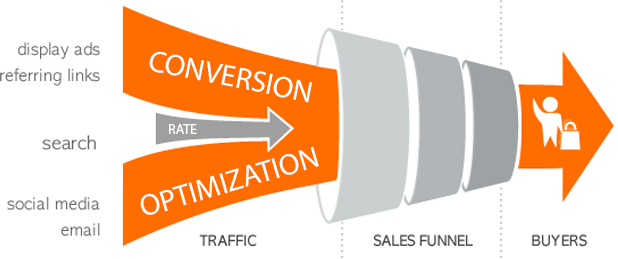Conversion rate is one of the most important KPI’s of an ecommerce website. Many people believe that it is all about traffic, but they’re wrong; you can’t have a successful online business without conversions, and you can’t have conversions without traffic; they’re both absolutely essential.
in website optimisation, it can be quite easy to build your amount of traffic up. There are a large number of ad services which will send massive amounts of traffic to you, but the conversion rate of that traffic is essentially 0.
This is just one example of how traffic is irrelevant if it doesn’t convert, but even in general SEO, if you optimise your site to bring in the largest audience, it doesn’t necessarily mean that it is going to bring in converting traffic.
If you look at content marketing as an example: Content marketing is essentially trying to produce content that people appreciate and take as fact. It draws people in, but doesn’t necessarily have the “hook” that most would associate with a marketing strategy. It is about developing presence as opposed to sales.
This is all well and good, but it does mean that your conversion rate is going to plummet. I’ll grant you, though, that if it is well done then content marketing can result in more sales. The problem comes in though, when you begin to organise content to target people’s queries as opposed to those among them looking to make a purchase.
If you take a Microsoft Excel training company as an example: Microsoft Excel is just about one of the most widely used pieces of software in business, and there is a great gap in the potential of the software and people’s skills with it. Most searches online for Microsoft Excel are therefore generally about people looking for quick answers to singular solutions; a content marketing campaign’s solution to this would be to provide the answer and then promote the fact that you can answer these questions. The downside to this strategy though, is that you’ve given pride of placement on your website to achieve good rankings for the related search terms, and sacrificed an opportunity to produce content that targets converting traffic. There is limited capital on a website for promoting important content and establishing relevance, so it generally is preferred to promote content that converts.
Moving on from how generating traffic and generating conversion rates can be in opposition, there are a wide range of strategies that businesses and marketers can employ to improve conversion rates.
One of the favourite strategies that people employ is called AB testing. This is where you have two versions of the same webpage, each with slight variations. You let a sample of people interact with each version of the webpage and from there determine the conversion rate for each version.
AB testing, and other strategies to develop conversion rates, are often used with heatmap technology. This shows how people’s cursors have interacted with the page, which can give you useful insights into the psychology of your users. Typically you’ll be able to see whether your users are struggling to find content that they want to find, and if they aren’t interacting well with your dynamic content.
Another essential tool for conversion rate optimisation is Google Analytics and ecommerce tracking. Google Analytics isn’t essential as there are alternatives, but it is a very useful and completely free, including free online tutorials in using it. You can use the analytics platform to discover how users are flowing through your website; how many pages they have to visit before they convert and how and where they bounce off the website.

